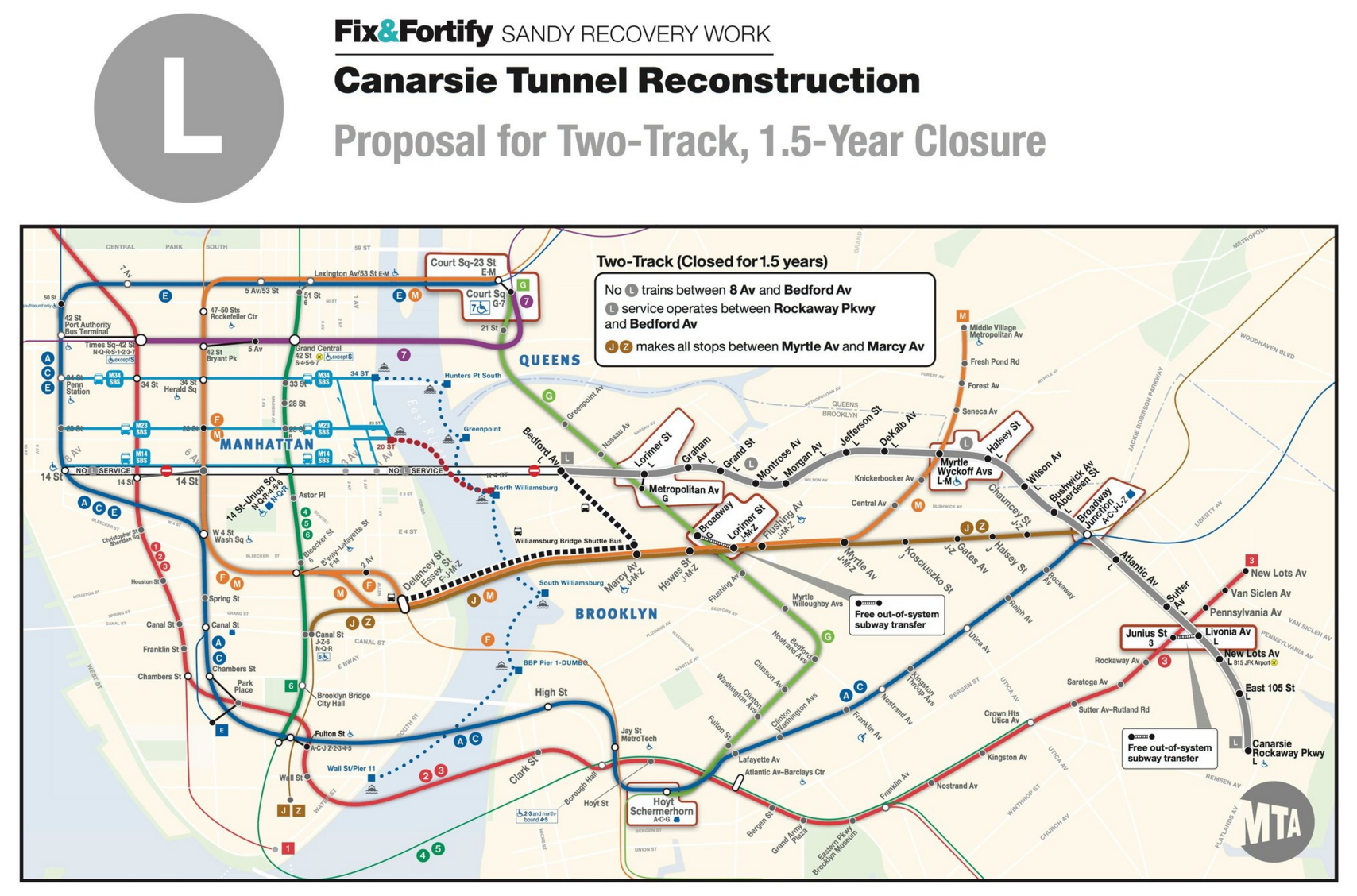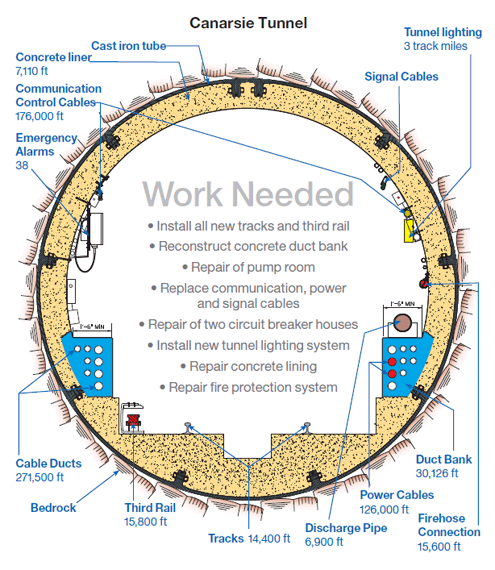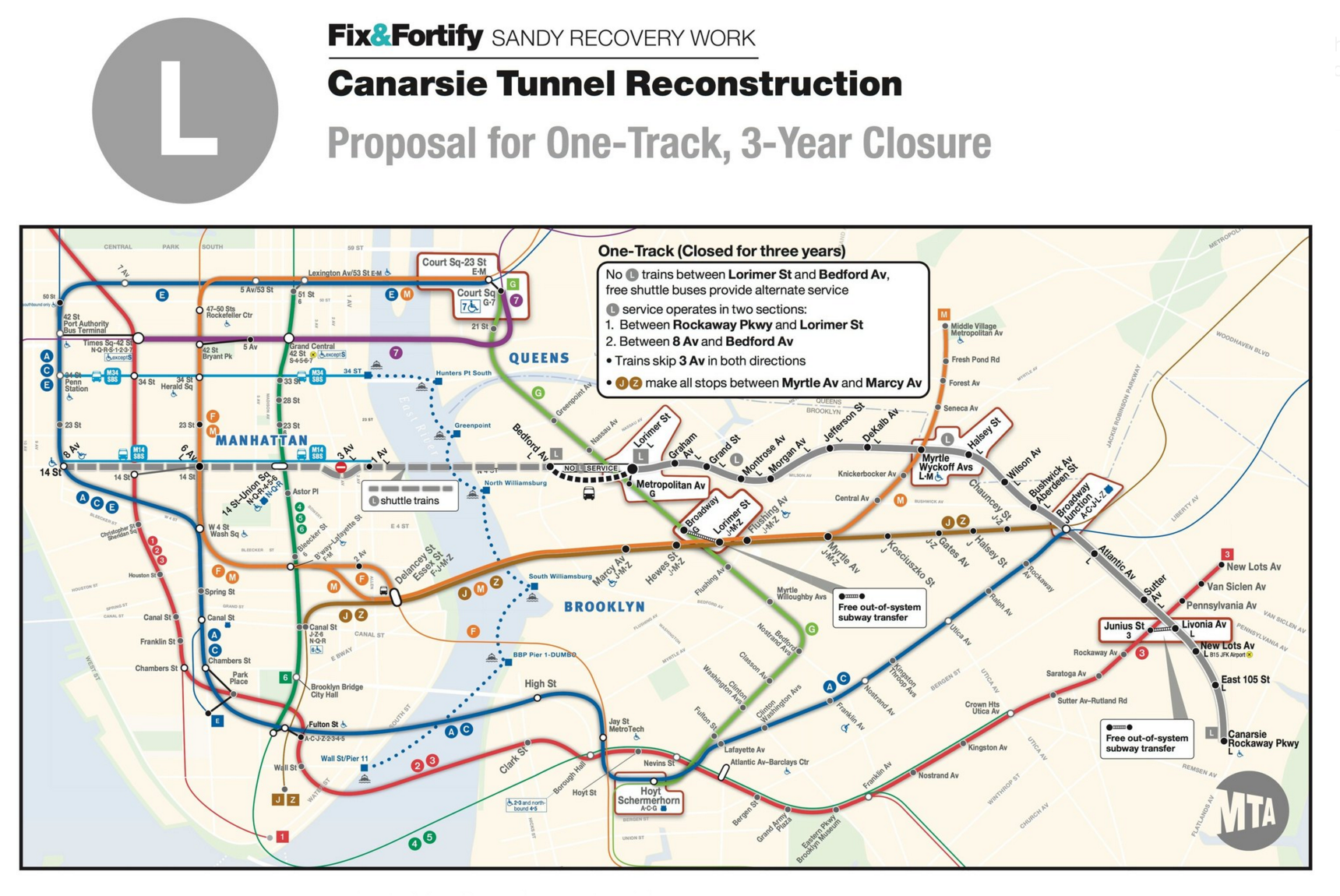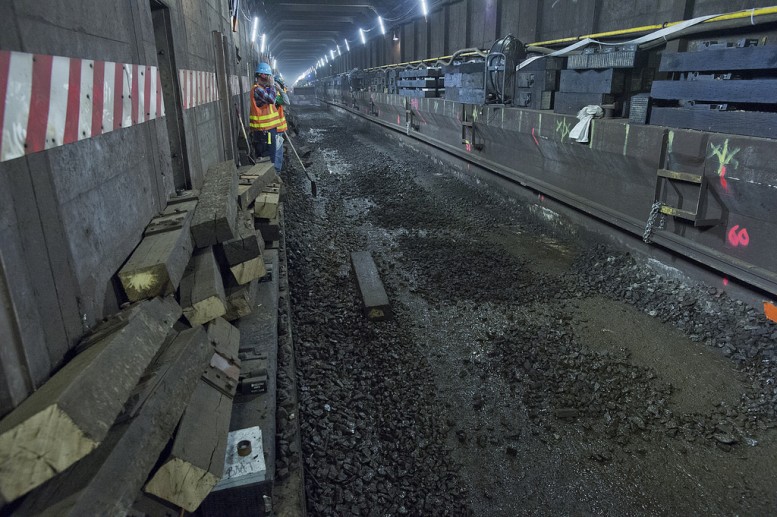The MTA held the first of two major public meetings on the looming L train shutdown at the Marcy Avenue Armory in South Williamsburg last night.
Top MTA brass presented the details for the two possible L trainocalypse options – a partial three year shutdown or a full eighteen-month shutdown. For those who have been following the issue closely, the Times laid out many of the details yesterday. The transit agency hopes to decide on a plan in the next few months, after getting community input and talking to community boards along the L train.

The eighteen-month, full shutdown plan for the L train. image via MTA
Officials offered a compelling case for fixing the tunnels sooner rather than later. MTA Chairman Tom Prendergast argued that, “If we were to do nothing, sections of the bench wall [that hold in the electrical cables] would fall.” They projected dramatic photos of the tunnels submerged in water after Hurricane Sandy, when seven million gallons of salt water flooded the century-old L train tubes. Before the meeting started, attendees could examine signal boxes and cables that had been corroded by Hurricane Sandy, which the MTA had displayed on a table in the back half of the armory.
“The MTA could lose hundreds of millions in federal [Sandy relief] funding if the work isn’t contracted soon,” explained New York City Transit President Veronique Hakim. “We worked hard to get those funds, and we need to commit to them before the end of the year.”

Canarsie Tube repair, image via MTA
L train repairs are expected to cost between $800 million and $1 billion, and the federal government is footing $700 million worth of that bill, according to Rep. Carolyn Maloney, who spoke after the MTA officials.
Prendergast and Hakim made a strong argument for the shorter, eighteen-month option. Here’s the rundown:
• Both tracks on the underwater section of the Canarsie Tube would shut down between Bedford Avenue and 8th Avenue in Manhattan, beginning in January 2019 and continuing through July 2020.
• 80 percent of riders wouldn’t be impacted by service changes (according to the MTA)
• L train service would run as normal in Brooklyn, but there would be no crosstown service along 14th Street in Manhattan.
• Contractors would have stronger incentives to finish the repair work ahead of schedule.
• The MTA is considering free out-of-system transfers between the Livonia Avenue L train stop and Junius Street 3 train stop in Brownsville (even though the agency has already pledged to build a link between these two neighboring stations), and between the Lorimer J train stop and the Broadway G stop.

The single-track, three-year plan for the L train repairs. image via MTA
Then there’s the three-year option, which would involve shuttle trains between Brooklyn and Manhattan, starting in January 2019 and ending sometime in 2022.
• Trains would run once every 12 to 15 minutes at stations between 8th Avenue and Bedford Avenue, skipping Third Avenue in both directions.
• No trains would run between Bedford Avenue and Lorimer Street. MTA’s Chief of Operations Planning, Peter Cafiero, explained that if trains run between Bedford and Lorimer, it doesn’t leave enough room for workers to safely access the tunnel site. Trains may also have to turn around on this section of track.
• The shuttle train between Bedford Avenue and Manhattan would only accommodate one out of every five riders, and MTA officials are worried about crowding, particularly at Bedford Avenue. On a typical day, 225,000 people ride the L train between Brooklyn and Manhattan.
• The L would run between Bedford Avenue and Canarsie on a slower-than-normal schedule.
The agency has ruled out the possibility of doing work on nights and weekends over the course of seven years. Even if the L was shut down every weekend, it wouldn’t be ready to run again until the following Tuesday or Wednesday. Ripping out the existing cables in the underwater tunnels will release toxic silica dust, and the cleanup work takes too long for that option to be feasible on a regular basis.
Some L train riders have asked the MTA to consider building a new underwater tunnel. But officials say that would be far too expensive and time consuming. A new tunnel, Prendergast explained, would take five to seven years to build.
Even though it was a public meeting, the MTA asked attendees to write out their questions on comment cards, instead of allowing the public to stand up and speak. Somewhere between 100 and 150 people showed up to the forum, but dozens had left by the time officials finished speaking around 8 p.m.
Regardless of which option the MTA chooses, it plans to boost frequency and capacity on the J, M, and G lines. The G train will be lengthened with extra cars, and the M will run into Manhattan 24/7. The agency also plans to increase service on the B39 bus, which travels across the Williamsburg Bridge, and may run a shuttle bus between Bedford Avenue and the Lower East Side. The agency also hopes to run a Select Bus Service across 14th Street and up to 23rd Street, where a ferry could shuttle passengers across the river to Williamsburg.
But questions about how frequently the shuttle buses would run, whether commuters could ride the ferry for the cost of a subway swipe, and how increased traffic would affect the Williamsburg Bridge, remain unanswered.
The MTA will hold a second public meeting on May 12 at 5:30 p.m., at the Salvation Army Theater in Manhattan.
Subscribe to the YIMBY newsletter for weekly updates on New York’s top projects
Subscribe to YIMBY’s daily e-mail
Follow YIMBYgram for real-time photo updates
Like YIMBY on Facebook
Follow YIMBY’s Twitter for the latest in YIMBYnews


Especially subway that move commuters to the city with crowded, if flooded alive in tunnel so people can get dangerous travel and life.
Great that are going to fix the problems.